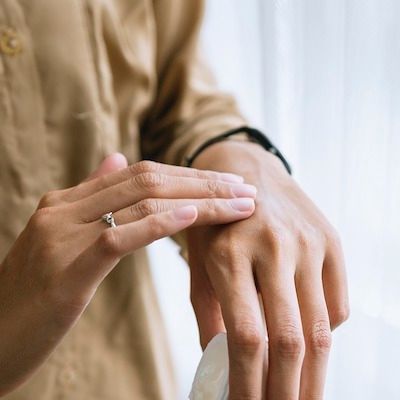Opinion
Video
New Topical Therapies in Plaque Psoriasis
Experts in dermatology comment on tapinarof and roflumilast, 2 nonsteroidal topical therapies recently approved for treatment of plaque psoriasis.
Lauren Miller, MPAS, PA-C: So transitioning over from oral therapies, we’ve got some new topical therapies that have been really exciting as well. And we’ve got roflumilast. We also have tapinarof that was approved. So we have oral therapy. We have had an unmet need in that realm, but we’ve also had an unmet need in topical therapies as well. When it comes to having new molecules. We have a lot of me-too products, a lot of steroids that just get refurbished and recycled. But we’ve got 2 new nonsteroidal options on the market now. Where do you see those playing in, and where have you put those in your toolbox when it comes to your [patients with] psoriasis?
Jayme Heim, MSN, FNP-BC: I love it. This is just awesome. We have not had a topical product to really enthusiastically talk to our patients about for such a long time.
Lauren Miller, MPAS, PA-C: 1997. I’ll tell you when it was.
Jayme Heim, MSN, FNP-BC: And even if we had something in a steroid that was a little bit more cosmetically elegant, we still had to worry about access problems. So we had a lot of generics that we were still utilizing. I love the fact that we can use this medication on sensitive skin areas—face, groin, underarm, inner thigh, and the other areas of the body, besides once-a-day application. And it’s not greasy, it’s not sticky. Neither one of them is. The both of them, there are 2 different mechanisms of action; one is a PDE4 [phosphodiesterase-4] inhibitor, and the other one is the aryl hydrocarbon antagonist or receptor antagonist…and just to tell people that we have something new, that works for psoriasis and we don’t have to worry about any kind of atrophy in that. And the [adherence] is so much better with a once-a-day application.
Lauren Miller, MPAS, PA-C: I’m one of those who, anytime we have a topical therapy, want to feel it for myself before I prescribe it. And they both have a very velvety feel that once you apply it and you give it a few seconds, you really can’t even tell that you have anything on. Which has been great because like you said, you can pretty much use it head to toe, any area, sensitive area, face, eyelid, skin folds. So, I’ve highly utilized those. That kind of moves us into another question that I had. When we talk about combination therapy, have you utilized these new topical therapies with systemic options, whether they be orals or biologics?
Jayme Heim, MSN, FNP-BC: Well, whether it’s orals or biologics, we know that psoriasis, even under the best conditions, is never completely steady state. We just are starting to hit fall. Kids are going back to school. There are so many stressors going on in families. Things are going on.… Sunlight is an important part. I live in Michigan. You live in Alabama. Michigan is really important. People get out there in the summertime. Of course, I’m always preaching SPF [sun protection factor]. Yes, but it does help with some of the apoptosis for those fast-growing cells…. And then the fall comes and there are a lot of stressors that come with a change of season in that. So patients will come in and they’ll have tiny flares. They’re not failing therapy. They’re not going back to baseline by any means, but they’ll have a plaque or someplace where they’re developing a little bit of scale. That’s where it’s just so phenomenal because you can go ahead and treat with this medication, especially for the sensitive areas or the other areas. It works very effectively. It’s cosmetically elegant. And right now, access is good for these medications. And this is another situation where the insurance companies really need to wake up and get these medications on formulary.
Lauren Miller, MPAS, PA-C: They do. It’s really funny because when I talk to patients about some of these newer topical options, I utilize specialty pharmacies in order to get these. But I’ll talk to them and say, “OK, I’m going to prescribe roflumilast, I’m going to prescribe tapinarof.” And they say, “OK, and what else?” And I say, “No, that’s all I’m going to prescribe.” But they’ve been so used to having to do multiple topical prescriptions, something for that sensitive area that’s a nonsteroidal, something for the thicker areas of the skin, like the elbows and the knees; that’s going to address the hyperkeratosis. And so when I talk to them about, “No, this is kind of a one-stop shop that we’re able to do now,” sometimes I think they’re a little perplexed and a little like, “OK, I don’t know that she knows what she’s talking about,” but then they’re really excited that, one, they can save on co-pays because it’s 1 product. And again, it’s once-a-day, 1 product. They don’t have to think about their diseases often.
Jayme Heim, MSN, FNP-BC: Oh, how many times, Lauren, do we have people come in and they have this baggie and they dump it out and [say,] “I forgot what I need to use where.” And because the instructions are on the box, they throw the box away and they have all these tubes, and then all of a sudden, they have a flare.
Lauren Miller, MPAS, PA-C: And we don’t need to worry about the clobetasol going in the groin area or under the arms.
Jayme Heim, MSN, FNP-BC: We’ve already told them, “No, you cannot put clobetasol on your face because [of] the possible the risk of glaucoma.” They don’t want to develop glaucoma. And some patients have family members who have had glaucoma. So, it’s just they don’t want to put them in the wrong areas. At the same time, they need to make sure. So here you are writing down this sheet of paper for them, their names and where to use them all again. And for patients, too, I’ve actually had to sometimes write a little tape and put it on there too, for them. And it’s just it’s so nice to not to have to do that. It’s wonderful for them. It’s wonderful for us. It’s wonderful for our clinical staff too.
Lauren Miller, MPAS, PA-C: Yes. Fewer callbacks, just all the way around. It’s been a really exciting time for providers [treating psoriasis], [patients with] psoriasis having the new oral options, new biologic options, new topical therapies. This really is the time when I tell patients, it almost seemed like, to patients, it almost was a death sentence 15 years ago when I would tell them that they had plaque psoriasis. You could see their head go down and you could see the look on their face. They felt very defeated. And now I can say, “Oh, honey, don’t worry about that. We can fix this.” And, you know, I say “fix” in a way of “You’re still going to have the disease, but the goal is to get it to where you don’t have to think about the fact that you have it.” And we actually can do that for you now. And we can do it a lot easier than we could 15 years ago.
Transcript is AI-generated and edited for clarity and readability.





